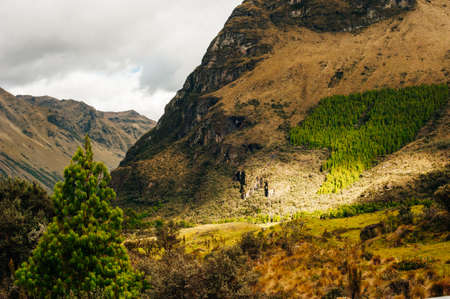Introduction to the Cairngorms: Scotland’s Untamed Wilderness
Welcome to the wild heart of the Scottish Highlands—Cairngorms National Park, a sprawling expanse where untamed nature and ancient culture collide in exhilarating fashion. This is not your average stroll in the park; it’s an invitation to adventure, where every path cuts through heather-clad moors, windswept summits, and pine forests echoing with history. The Cairngorms are legendary across Britain for their raw beauty and unpredictable weather, making each hike a true test of mettle and spirit.
Home to towering Munros, crystal-clear lochs, and red deer darting through misty glens, this rugged terrain has shaped Scottish folklore for centuries. Locals speak of ‘Dreich’ days—those gloriously grey, atmospheric mornings that set the scene for stories of clan battles and mystical creatures. But it’s not all myth; here you’ll find both seasoned hillwalkers and intrepid explorers lacing up their boots for a proper ramble, fuelled by hearty banter and perhaps a flask of whisky tucked away for the summit.
What truly sets the Cairngorms apart is its spirit—a palpable sense of freedom and challenge that beckons you off the beaten track. Whether you’re scaling Ben Macdui under brooding skies or weaving through ancient Caledonian pinewoods near Aviemore, every route promises a unique blend of adrenaline and awe. Embrace Scotland’s renowned hospitality in the villages dotted along your way, where you can swap tales with locals over a steaming bowl of cullen skink or a fresh-baked bannock.
This guide is your passport to conquering some of the UK’s most thrilling trails, from gentle woodland wanders to full-blown mountain expeditions. So tighten your laces, pack your waterproofs, and get ready—the Cairngorms await those bold enough to answer their call.
2. Essential Kit and British Hiking Know-how
If you’re planning to tackle the wild expanse of Cairngorms National Park, your adventure begins long before you set foot on the trail. Success in Scotland’s highlands demands more than just grit—it’s about being kitted out for every eventuality and knowing how to dance with the elements. Here’s how to prep like a seasoned Brit, blending practical hillwalking know-how with a dash of local wisdom.
Indispensable Gear for Cairngorms Hillwalkers
| Item | Why It Matters | British Top Tip |
|---|---|---|
| Waterproof Jacket & Trousers | Scottish weather is infamous for its mood swings—sunshine one minute, horizontal rain the next. | “If you haven’t got your waterproofs, you’re not going far!” – always pack even if skies are blue. |
| Sturdy Walking Boots | Boggy moors and rocky ridges will chew up flimsy footwear. | Opt for boots with proper ankle support and break them in on shorter walks before your trip. |
| OS Map & Compass | Phone signals can vanish in remote glens. | Master traditional navigation—many locals swear by Ordnance Survey maps over GPS alone. |
| Laminated Route Card | Your planned route, timings, and escape points—a must in case weather turns sour. | Share your route with a friend or B&B host; “leave a note, don’t become a headline.” |
| Midgie Repellent | The dreaded Scottish midges can turn an epic into an ordeal. | Packing Smidge or Avon Skin So Soft is considered wise as well as local lore! |
| Insulated Layers & Hat/Gloves | The temperature can plummet, especially above 600 metres—even in July! | “Four seasons in one day” isn’t a joke—bring more than you think you’ll need. |
| Snacks & Emergency Rations | Cairngorms distances deceive; energy dips fast on long days out. | Packed sandwiches, flapjacks, and a flask of tea are classic British hill food staples. |
| First Aid Kit & Whistle | Help could be miles away; self-reliance is key. | A whistle (6 blasts for distress) is part of the Mountain Code here. |
Tackling Unpredictable Weather: The British Way
The Cairngorms are notorious for rapid weather shifts—mist rolling in without warning, sleet in August, and winds that could knock a stag off its feet. British hikers thrive by expecting the unexpected. Always check the Mountain Weather Information Service (MWIS) before setting out. Layer up so you can peel off or pile on gear as conditions change. And remember: “There’s no such thing as bad weather, only unsuitable clothing.”
Unique Local Wisdom: Blending In With the Brits
- If you hear “It’s just a wee walk”—be prepared for hours and possibly a scramble or two!
- Avoid stepping on peat bogs where possible; they suck boots like quicksand and leave many red-faced walkers stranded.
- The right to roam is sacred here, but respect gates, livestock, and leave no trace—“Take only memories, leave only footprints.”
- Nip into a bothy (mountain hut) if weather gets wild—these stone shelters are lifesavers and social hubs for hardy walkers.
The Adventure Mindset: Be Ready for Anything
Treat every hike in the Cairngorms like an expedition: anticipate setbacks, relish surprises, and keep spirits high with gallows humour when the drizzle sets in. With the right kit and classic British hiking nous, you’ll be ready to take on whatever these untamed mountains throw at you—and come home with legendary stories to tell.
![]()
3. Top Adventure Trails: From Ben Macdui to Loch an Eilein
If youre craving the raw thrill of wild Scotland, Cairngorms National Park is your ultimate playground. This ancient land is stitched together by a tapestry of legendary hiking trails—some renowned, others whispered about in bothy firesides. Here’s our roundup of the most exhilarating walks, where every step is a brush with adventure and Scottish myth.
Ben Macdui: Munro-Bagging Royalty
No serious hiker can resist the call of Ben Macdui. As Britain’s second-highest peak, it’s a true rite of passage for munro-baggers. The classic route from Cairn Gorm ski centre is a relentless ascent through rocky wilderness, battered by capricious Highland weather. On a clear day, you’ll catch sweeping views over the Lairig Ghru and perhaps even glimpse the elusive Grey Man—a spectral figure said to haunt the summit. This trek demands grit, navigation skills, and a love for unpredictable Scottish elements.
The Lairig Ghru: Crossing Cairngorms’ Spine
The Lairig Ghru isn’t just a walk—it’s a full-on expedition slicing through the heart of the mountains. This legendary pass was once used by drovers and outlaws alike, running from Aviemore to Braemar. Expect boulder fields, vast moorlands, and an atmosphere thick with Highland lore. It’s wild country, where weather turns on a sixpence and remoteness humbles even seasoned ramblers.
Loch an Eilein: A Fairytale Woodland Circuit
For something less punishing but equally magical, circle Loch an Eilein. Nestled in Rothiemurchus Forest and crowned by a ruined island castle, this walk is straight out of Scottish folklore. Pinewoods echo with birdsong; red squirrels dart across your path. Keep your eyes peeled for stags amid morning mist or the glint of faerie lights as dusk settles—a gentle yet enchanting adventure suitable for all abilities.
Hidden Gems: Ryvoan Pass & The Green Lochan
If you’re after solitude and surprise, venture up Ryvoan Pass to An Lochan Uaine—the Green Lochan. Local legend claims its vivid emerald hue comes from fairies washing their clothes here. The trail meanders past ancient pines and open moors before revealing this otherworldly loch—proof that not all Cairngorms wonders tower above sea level.
Folklore-Laced Walks: The Pass of Ryvoan & Beyond
Many trails in the Cairngorms pulse with stories passed down generations. Try the circuit around Glenmore Forest for echoes of clan gatherings or step onto paths near Kingussie where tales of kelpies and ancient battles still linger on the wind.
Whether you’re hunting munros or seeking secret glens shrouded in mist and myth, Cairngorms National Park delivers proper adventure—no matter how far you stray from the beaten track.
4. Navigating the Wild: Safety, Etiquette, and Local Customs
Venturing into the heart of Cairngorms National Park is not just a stroll up the hill—its a true British adventure, where respect for the land and local ways is paramount. Here’s your crash course in surviving and thriving among Scotland’s wildest peaks, featuring hard-earned wisdom from seasoned UK hillwalkers.
The Countryside Code: Your Essential Compass
Before you lace up those boots, get to grips with the Countryside Code—a cornerstone of hiking etiquette in Britain. Following these guidelines ensures both your safety and that you remain in good stead with locals and fellow adventurers alike.
| Rule | What It Means in Practice |
|---|---|
| Respect everyone | Keep noise down, greet fellow hikers with a nod or “Alright?”, and always give way to those heading uphill. |
| Protect the environment | Stick to paths to avoid erosion, take litter home, and never pick wildflowers or disturb wildlife. |
| Enjoy responsibly | No wild parties—leave only footprints and keep dogs under close control, especially near livestock. |
Mountain Safety: Surviving the Scottish Elements
Cairngorms weather can turn on a dime. Even the most cocksure adventurer will be humbled by sudden fog or a howling squall. Here’s what every savvy hillwalker packs (or wishes they had):
- OS Map & Compass (and the skill to use them—don’t rely on your phone!)
- Waterproof layers—because “a wee shower” can mean torrential rain
- Plenty of snacks—think oatcakes, not just Kendal Mint Cake!
- A headtorch—even in summer, Scottish dusk creeps up quickly
- First aid kit and whistle for emergencies
- Mobile phone in a waterproof pouch (signal is patchy at best)
Quirky Dos and Don’ts: The Unwritten Rules of UK Hillwalking
| Do… | Don’t… |
|---|---|
| Nod or say “Morning!” to passers-by—it’s tradition! | Treat cairns as playthings—they’re navigation aids, not art installations. |
| Close gates behind you—always! | Assume every path is public—check access rights first. |
| Praise someone’s dog—it’ll make their day. | Bottle it when faced with boggy ground—sometimes you’ve just got to wade through. |
A Word on Bothies and Local Hospitality
If you stumble upon a bothy—a rustic mountain shelter—remember they’re communal. Leave it tidier than you found it, share stories round the fire, and never leave food behind (unless you want to feed the mice).
The Cairngorms Spirit: Respect Earns Respect
The unwritten code out here is simple: look after each other, mind your manners, and embrace whatever madness the weather throws at you. Do this right, and you’ll earn yourself a place in the proud lineage of British hillwalkers who’ve conquered these wild lands before you.
5. Après-Hike: Scottish Pubs, Bothies, and Cosy Traditions
Legendary Pubs: Raise a Dram to the Highlands
After conquering the wild trails of Cairngorms National Park, there’s no better way to toast your achievement than with a visit to a traditional Scottish pub. Whether you’re muddy-booted or windswept, locals will welcome you with warm banter and perhaps a peaty single malt whisky. Venture into watering holes like The Old Bridge Inn in Aviemore or Glenmore Lodge Bar—places where both climbers and hillwalkers swap stories by crackling fires. Dive into hearty fare: think haggis, neeps, tatties, and cullen skink, washed down with local ales. Here, laughter mingles with folk music and the unspoken camaraderie of those who’ve braved the same wild peaks.
Bothies: Highland Hospitality Off the Grid
For the truly adventurous, Scotland’s bothy culture is nothing short of legendary. Scattered across remote glens and forest edges within the Cairngorms, these rustic shelters are open to all who seek refuge from the elements. Picture this: after hours battling wind and rain on the Lairig Ghru, you stumble upon a stone bothy—a beacon of hope in the vast wilderness. Inside, strangers become friends as tales are shared by candlelight over steaming mugs of tea (or whisky). There’s no electricity or running water—just raw Highland hospitality and the timeless ritual of drying out boots by the fire.
The Magic of Cosy Scottish Traditions
Unwinding après-adventure is an art form in the Cairngorms. Beyond pubs and bothies lies a tapestry of Scottish traditions designed for ultimate comfort after a day outdoors. Wrap yourself in a tartan blanket at a guesthouse overlooking heather-clad hills; let homemade shortbread and rich fruitcake refuel tired legs. Some villages host impromptu ceilidhs where hikers are swept up in reels and jigs alongside locals. Others offer sauna sessions or guided whisky tastings—perfect for melting away the chill of a mountain evening. Whether you’re tucked up beside a roaring log burner or lost in laughter at a bustling village inn, this is Scotland’s true reward for those who dare to explore her wildest corners.
6. Seasonal Challenges and Extreme Weather
Weathering the Cairngorms: A Year-Round Adventure
If you think Scotland’s Cairngorms National Park is all rolling hills and gentle strolls, prepare for a lesson in meteorological mayhem. Each season here presents its own brand of wildness—making hiking in this region an exercise in both preparation and grit. Whether you’re tackling wind-scoured peaks in January or dodging clouds of midges come July, the extremes are part of what makes these adventures legendary.
Winter Ascents: Braving the Beast
Winter in the Cairngorms isn’t just cold—it’s an all-out assault on your senses. Gale-force winds howl over icy plateaus, whiteouts can appear without warning, and even seasoned Munro-baggers know to treat each ascent with respect. If you’re keen to embrace a true British winter epic, bring crampons, ice axes, and the knowledge to use them. Check the Mountain Weather Information Service (MWIS) before heading out, and never underestimate the Scottish tendency for four seasons in a single hour.
Summer: Sunburn, Showers, and Swarms
Don’t be fooled by longer days and blue skies; summer hiking here is far from a picnic. The notorious Highland midge makes its presence felt—these tiny biting insects can turn a tranquil evening lochside into an extreme test of patience. Invest in a good midge repellent or net headgear if you value your sanity. On the plus side, endless daylight means you can stretch your adventure into the late hours—just pack for sudden showers and keep that waterproof handy.
Spring and Autumn: Unpredictable Beauty
The shoulder seasons are perhaps when the Cairngorms are at their most unpredictable—and their most beautiful. Spring brings gushing rivers and melting snowfields, while autumn drapes the landscape in golds and russets. But don’t let your guard down; rapidly shifting weather can catch even experienced hikers off-guard. Always carry extra layers, check forecasts religiously, and relish that sense of true adventure as you watch storm clouds tumble over distant corries.
Top Tips for Tackling Scotland’s Wildest Weather
- Layer up: Merino wool base layers, fleece mid-layers, and a bombproof waterproof shell are non-negotiable.
- Navigation: GPS is great but always carry a map and compass—and know how to use them.
- Midges: Midge-proof your kit in summer months; Avon Skin So Soft is a local favourite!
- Plan for darkness: In winter months, daylight is fleeting—start early and pack a torch.
To hike the Cairngorms year-round is to accept nature’s challenge head-on—so embrace every gust, midge, and squall with the spirit of a true British adventurer.
7. Sustainable Hiking: Leave No Trace in the Highlands
If you’ve made it this far into the wild heart of the Cairngorms, you already know these mountains command respect. But it’s not just about summiting Munros or chasing that next adrenaline spike—the real challenge is leaving these ancient lands exactly as you found them, if not better.
Treading Lightly: The British Way
Here in Britain, our love for a proper ramble is matched only by our duty to protect the countryside. Highland etiquette isn’t just good manners; it’s a lifeline for fragile ecosystems. Stick to marked paths where possible, resist the urge to shortcut across heather, and keep noise to a minimum—remember, you’re sharing space with red deer, capercaillie, and elusive wildcats. The unwritten rule? If you packed it in, pack it out. Litter—however small—is simply not cricket.
Supporting Local Conservation
The Cairngorms are more than a playground; they’re home to dedicated rangers and conservationists working tirelessly to restore peatlands, protect rare species, and manage visitor impact. Consider dropping a few quid in local donation boxes, volunteering with organisations like the Cairngorms Trust, or joining guided walks that support community projects. Every little helps—your contribution keeps both paths and traditions alive.
Safeguarding for Future Wild Souls
Sustainable hiking isn’t just about what we take—it’s about what we leave behind for those who follow. Share your knowledge of responsible adventure; show newcomers how to wild camp respectfully (think: tents gone by dawn, fires strictly banned). And always be prepared for rapid weather shifts; rescue teams are volunteers who’d rather spend their evenings at the pub than searching for lost walkers.
So here’s the call: explore boldly but mindfully. Let your legacy be one of care and respect—so that long after our boots have muddied these trails, future generations can answer the same wild call of the Cairngorms.


